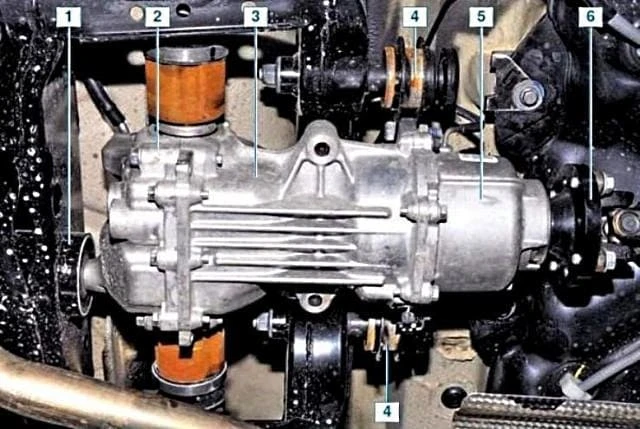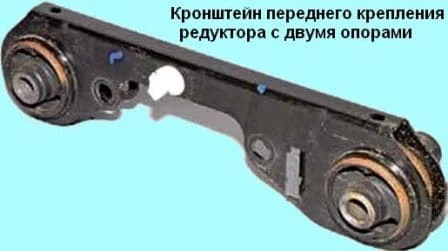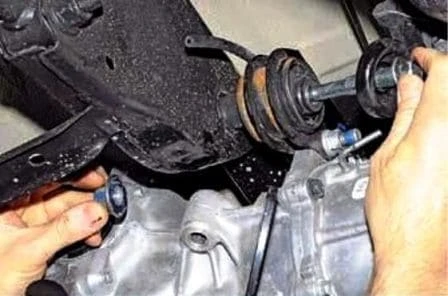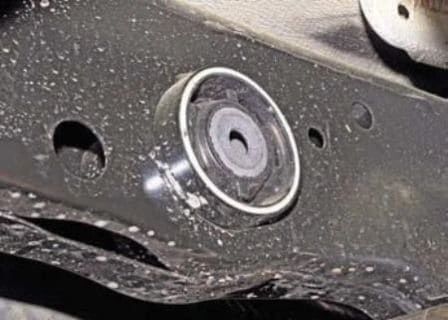In the rear gearbox of the car there is a final drive with a differential and an electromagnetic clutch
The main gear is hypoid.
The drive gear of the final drive is made integral with the shaft, the splined end of which is connected to the hub of the control clutch of the electromagnetic clutch

Rear gearbox: 1 - rear gearbox cover; 2 - breather tube; 3 - gearbox housing; 4 - housing of the electromagnetic clutch; 5 - flange of the electromagnetic clutch; 6 - block of wires of the electromagnetic clutch; 7 - holes for fastening the bracket of the front supports; 8 - stud fastening the gearbox to the rear support; 9 - left wheel drive oil seal; 10 - right wheel drive oil seal; 11 - drain plug; 12 - filler plug
The pinion shaft is mounted on two tapered roller bearings.
The outer rings of the bearings are pressed into the sockets of the gearbox housing, and the inner rings are put on the shaft.
A spacer is installed between the inner rings; when the bearing nut is tightened, the sleeve is deformed, providing a constant preload on the bearings.
The preload of the bearings is controlled by the torque of the drive gear.
The final drive gear is bolted to the differential box flange.
The differential transmits torque to the rear wheel drives and allows the drives to rotate at different angular speeds.
This allows the wheels to travel different lengths of path without slipping as they turn.
The differential box rotates in two tapered roller bearings.
In the differential box, there are two side gears and two pinion gears that are in constant engagement.
The satellites rotate around an axis fixed in the differential box.

Rear gearbox on a car: 1 - rear support; 2 - back cover; 3 - gearbox housing; 4 - front supports; 5 - housing of the electromagnetic clutch; 6 - electromagnetic clutch flange
The body of the electromagnetic clutch for connecting the all-wheel drive is bolted to the main gear housing.
The frictional electromagnetic clutch plays the role of a center differential - it redistributes the torque between the axles depending on road conditions.
The purpose of the clutch is to redistribute torque from the engine to the rear wheels in accordance with the selected drive mode.
The coupling allows you to connect and disconnect the drive gear shaft of the final drive of the gearbox with cardan drive.
Locking occurs due to the solenoid (electromagnet).
In 2WD mode, no power is supplied to the solenoid, the clutch is unlocked, and no torque is transmitted to the rear wheels.
The transmission works like a front-wheel drive car.
In 4WD AUTO mode, the clutch locks automatically, depending on the difference in wheel rotation.
When driving under normal conditions (when the front and rear wheels rotate at the same speed), the clutch is unlocked - all the torque goes to the front wheels.
If the front wheels (or the wheel) start to rotate faster (slip) at the command of the electronic control unit, voltage will be supplied to the solenoid within 0.1 seconds.
It blocks the clutch, and the torque is distributed between the front and rear wheels in a 50/50 ratio.
As soon as the grip of all wheels with the road becomes the same again, all power will be transferred to the front wheels again.
In 4WD LOCK mode, the clutch is permanently locked and 4WD is permanently engaged.
An electromagnetic clutch connects the rear-wheel drive on command from the all-wheel drive control unit.
The leading part of the clutch is connected to the rear propeller shaft, and the driven part is connected to the final drive gear shaft.
In the driven part there is a cam mechanism that changes the clamping force.
The current supplied to the clutch solenoid causes the rear axle to engage.
The amount of transmitted torque is regulated by the adhesion force of the friction discs in the clutch.
At maximum current, the coupling is hard locked.

The gearbox is fixed on three supports to the rear suspension subframe.

The bracket with the front supports is attached to the rear gearbox housing with two bolts and nuts.

The stud of the gearbox cover is inserted into the hole in the rear support and fastened with a nut.

Two breathers are used to equalize the pressures inside and outside the rear gearbox and the electromagnetic clutch.

To clean the breather, remove the breather tip from the holder and rotate it on the hose.
Possible gear failures and troubleshooting
- Cause of malfunction
Remedy
Four-wheel drive is not connected:
- The electrical contact in the wiring harness of the electromagnetic clutch is broken or the electrical circuit of the all-wheel drive control system is damaged
Restore the electrical contact in the block, troubleshoot the circuit
- The four-wheel drive control unit is faulty
Replace electronics
- The electromagnetic clutch for connecting the all-wheel drive is faulty
Repair or replace clutch
Constant increased noise during operation of the rear axle:
- Incorrect adjustment, damage or wear of gears or gearbox bearings
Repair or replace the rear axle gearbox
- Worn or incorrectly adjusted differential bearings
Repair or replace the rear axle gearbox
Noise during car acceleration and engine braking:
- Not enough oil
Refill the oil level and check for leaks in the seals
- Incorrect adjustment of the main gear engagement
Repair the rear axle reducer
- Incorrect lateral clearance in the meshing of the final drive gears
Repair the gearbox
- Increased clearance in the drive gear bearings due to bearing wear
Repair the gearbox
Knocking at the beginning of the movement of the car:
- Wear of the hole for the axis of the satellites in the differential box
Repair the rear axle reducer
Oil leak:
- Wear or damage to the seals of the internal joints of the rear wheel drives
Replace oil seals
- Loosening of the bolts securing the side cover to the rear axle gear case, damage to the cover gasket
Tighten bolts, replace seal
Checking the electromagnetic clutch
When a malfunction is detected in the transmission, the control unit enters the 2WD (front-wheel drive) mode, while warning lamps in the instrument cluster light up.
In this case, you can continue driving at low speed to the service station.
Checking the electromagnetic clutch is carried out on a viewing ditch or a lift.
Disconnect the negative battery terminal

To check the winding of the electromagnetic clutch, remove the clutch control wire blocks from the plastic holder

By pressing the latch, we separate them

Connect the tester probes in ohmmeter mode to the block.
If the tester shows infinity, then there is a break in the winding and the clutch needs to be replaced.





